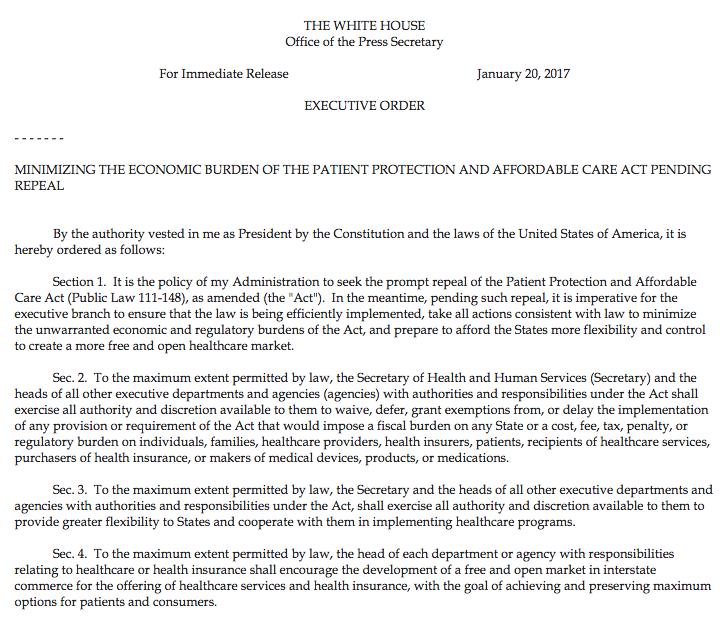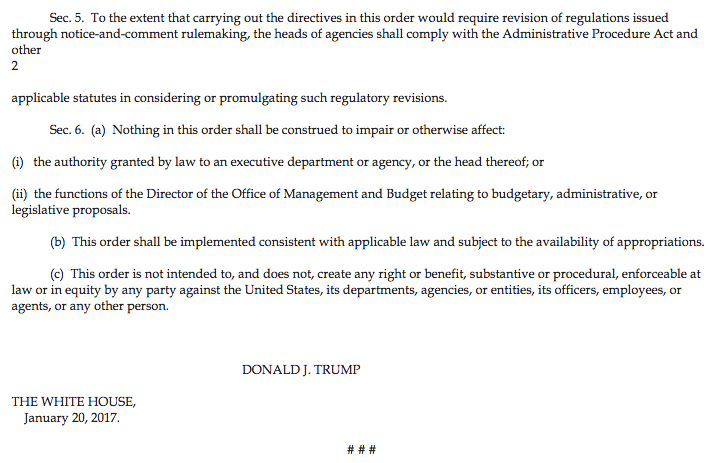
WASHINGTON — President Donald Trump vowed to repeal Obamacare throughout the campaign, and on his first day in office, he signed an executive order making clear he's serious about that promise.
The order directs every agency that has jurisdiction over the law to find ways to delay or waive provisions that would "impose a fiscal burden."

But how exactly this order will be implemented, and its practical effects, is unclear.
Obamacare isn't going away overnight. Because the Trump order is very broad, insurance companies and other health care stakeholders will need to wait to see what agency heads end up deciding to do, several insurance sources said.
The vast majority of provisions of the law require Congress to help overturn them. But Trump's executive order does give the agencies a directive to start finding ways to weaken the law, as soon as they possibly can.
The biggest issue at hand is the individual mandate, the lynchpin that requires every American to buy insurance. The executive order directs federal agencies to waive, defer, or grant exemptions, to the maximum extent of the law, to provisions of the ACA that impose a cost.
Larry Levitt, vice president of the Kaiser Family Foundation said that if the agencies are able to exempt a large number of individuals from the individual mandate, insurance companies could quickly pull out the individual market.
"This is a very sweeping order that could have major ramifications for the ACA. Potentially the biggest step implied by this order would be granting wide-scale hardship exemptions from the individual mandate, which could create chaos in the individual insurance market," he said. "This order doesn’t create any new authority for federal agencies, but it signals that the Trump administration is planning to use whatever authority it has to scale back and undo provisions of the ACA."
An executive order still has to comply within the law, but the agencies, especially Health and Human Services, have a lot of flexibility in how they interpret the law. During the ACA's enactment, Obama used his executive order power to delay parts of its implementation.
Agency heads will also still have to go through the normal rule-making process to adjust or rollback certain regulations — a process that can take months.
The executive order has four main orders, which can be summarized as:
- Directs agencies to ensure the law is being implemented efficiently until it can be repealed.
- As mentioned above, directs agencies to grant as many exemptions as possible to ACA provisions.
- Directs agencies to grant greater flexibility to the states and cooperate with them in implementing healthcare programs.
- Directs agencies to "encourage the development of a free and open market."
There are two more sections, one dealing with regulatory logistics and the other acting as a legal disclaimer.
Trump's plan for the replacement of Obamacare remains unknown. Multiple proposals are expected to be introduced in the Senate this week, but top Senate Republicans say they still do not know Trump's plan.
A key player in repeal and replacement will be Tom Price, Trump's nominee for secretary of Health and Human Services. But Price has not yet been confirmed and has the second of two confirmation hearings scheduled for Tuesday.
Republicans in Congress are split over whether Obamacare repeal can begin in earnest before a replacement plan is clearly outlined. The next major crossroads in repeal is the upcoming budget reconciliation process. Republicans can use this tool to repeal some parts of the Affordable Care Act without Democrat support, but will need some Democrats in the Senate onside to pass any new replacement legislation.
Senate Minority Leader Chuck Schumer has repeatedly said the onus of replacement is on Republicans, and Democrats will not help craft a replacement bill until one is presented.
Read the order:



